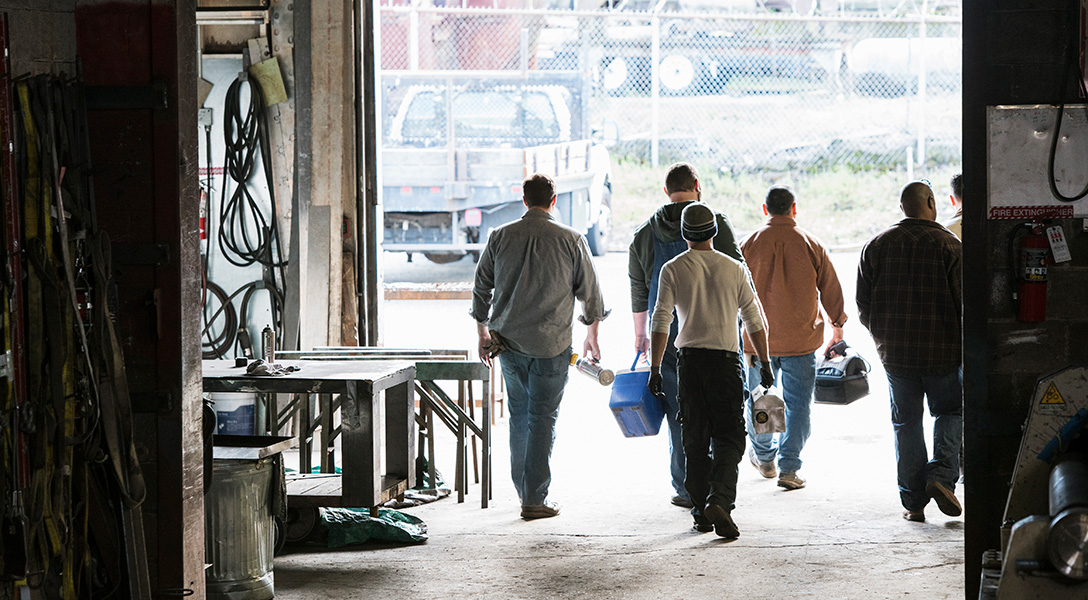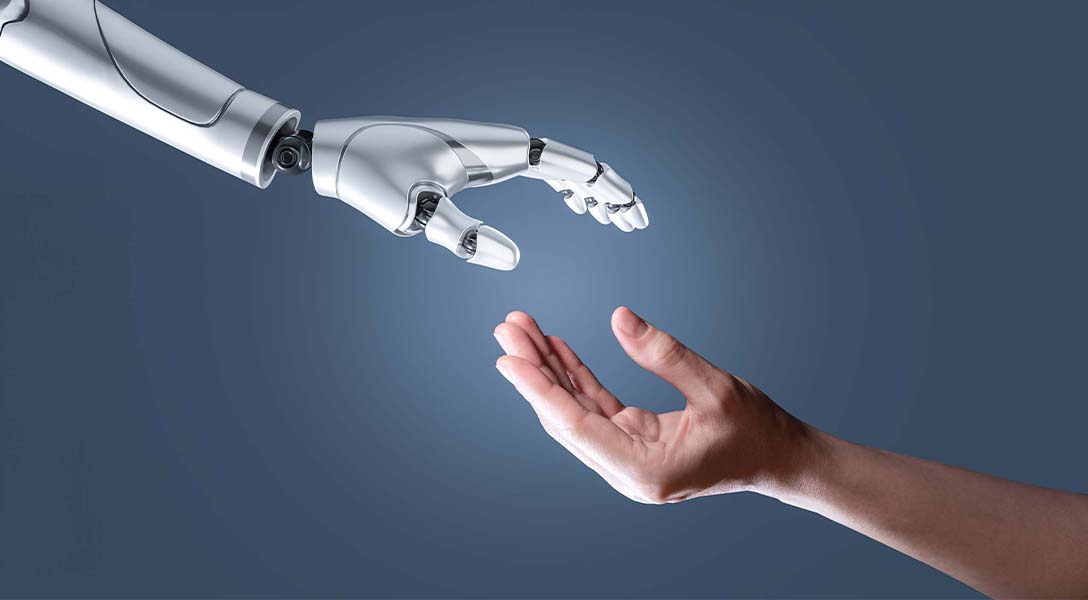
New disruption from artificial intelligence exposes high-skilled workers
Rapid technological development since the Industrial Revolution has presented workers with new tools to work more efficiently. It also has generated fear of losing jobs to machines.
While much of the worry about technology replacing workers has proved unwarranted, some more recent technological shocks, such as automation, have profoundly affected the labor market. Now, with workers still grappling with the consequences of automation, the lightning-speed pace of artificial intelligence (AI) development poses fresh concerns of a new wave of worker displacement.
AI brings new wave of disruption
In general, AI refers to algorithms that teach machines how to complete tasks by identifying statistical patterns in data, rather than following preset instructions provided by humans, the basis of the technology developed during the automation revolution.
Unlike computerization and automation, which forged tools good at performing repetitive, routine tasks at scale, the algorithms employed in AI technologies are capable of performing highly nonroutine tasks previously only performed by highly skilled workers with sophisticated training.
For example, AI could rapidly analyze a massive volume of financial data to identify data points indicative of likely fraudulent transactions, a task that simple automation technologies cannot perform. A human auditor, who has accumulated years of training and job experience in fraud detection, could become vulnerable once such an AI application comes online.
In fact, research shows that the recent AI shocks leave mostly high-skilled white-collar workers highly exposed.
New generative AI poses higher displacement potential
AI technologies developed before 2022 were mainly limited to predictive AI, which analyzes data to recognize patterns and is largely geared toward functional tasks such as detection or forecasts. The recent advent of applications like ChatGPT (short for Chat Generative Pre-trained Transformer) radically expanded the range of applicability of AI because the GPT-based AI is generative.
That means that the AI can generate creative content based on big data. The generative AI can write articles, compose music and create art, all almost indistinguishable from those created by human beings. That capability means generative AI applications such as ChatGPT will likely expand the list of vulnerable occupations. Occupations commonly believed to be safe from replacement—such as language teachers, legal professionals and artists—may now face stiff competition from the superhuman performance of GPT services at scale.
Gauging AI’s impact by occupation
To gauge occupations’ degree of exposure to the three types of technological shocks—automation, pre-GPT AI and GPT AI—measurements from three separate studies are adopted. The degree of exposure to computerization/automation is from a widely used measure introduced by Carl Benedikt Frey and Michael Osborne (“The Future of Employment: How Susceptible Are Jobs to Computerisation?”).[1]
The authors identify the presence of job attributes that pose obvious bottlenecks to computerization, such as social perceptiveness and manual dexterity, and combine these attributes with engineers’ assessments to predict whether an occupation is exposed to computerization and automation.
The exposure to pre-GPT AI comes from dissertation research at Stanford University by Michael Webb (“The Impact of Artificial Intelligence on the Labor Market”). His approach classifies an occupation’s exposure to AI according to the likelihood that the technology could replicate the occupation’s job tasks based on detailed textual analysis of AI patents.
The exposure to GPT AI is constructed drawing on a 2023 research paper by Ed Felten, Manav Raj and Robert Seamans (“How will Language Modelers like ChatGPT Affect Occupations and Industries?”) linking frontier AI applications to human abilities. Then, based on the human abilities required in each occupation, they construct a measure that tracks how AI can replace humans.
Chart 1 shows the degree of exposure to automation, pre-GPT AI and GPT AI across the major occupation categories.[2] Unsurprisingly, blue-collar occupations such as food service and production tend to be most exposed to the automation shocks, while the higher-skilled white-collar jobs such as science and technology and education jobs tend to be much less exposed.
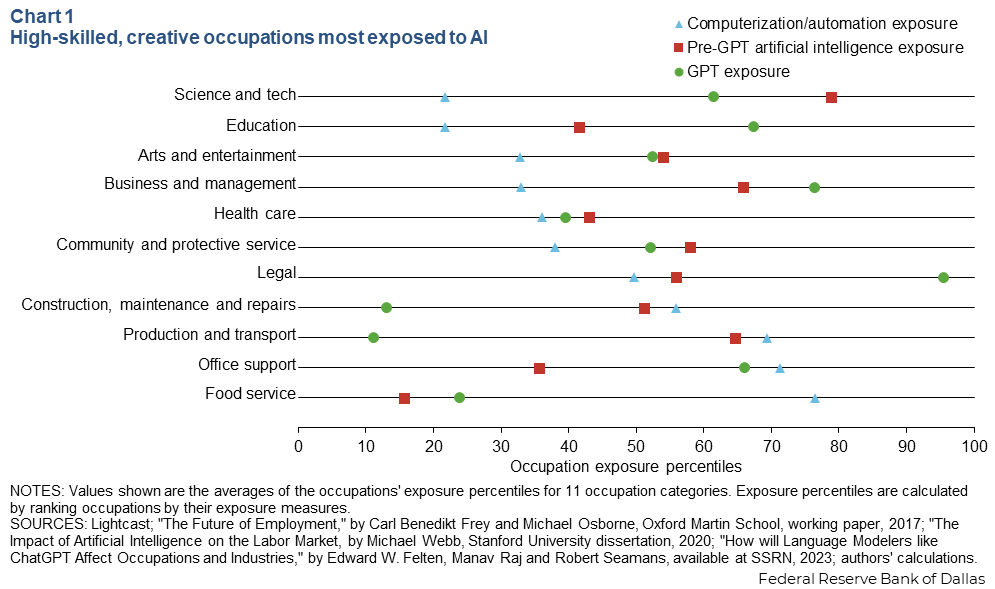
AI exposes highly skilled workers
The spectrum of industries exposed to AI is entirely different from those exposed to the previous automation shocks, with science and technology and business and management jobs among the most exposed. Generative AI such as the GPT applications (for example, ChatGPT) could further extend the sphere of AI’s impact to include highly skilled professionals such as educators and lawyers, whose work tends to be highly cognitive and nonroutine and has not been typically thought of as easily replaceable.
On the other hand, many noncognitive and routine occupations that the automation shock heavily affected were not very exposed to the AI shocks, since AI is particularly competitive at performing cognitive and nonroutine job tasks. For example, while automation technologies can perform many of the routine job tasks traditionally performed manually by food service workers, such as taking orders and food preparation, the current AI technologies do not yet pose significant replacement threat to the remaining physical tasks of those workers.
The pre-AI automation shock upended workplaces, communities
Research has documented that the automation revolution prior to the AI shocks resulted in significant employment losses among manufacturing workers, leading in some cases to chronic joblessness for displaced laborers and population decline and urban decay in some previously burgeoning industrial cities.
On the other hand, some areas and workers gained from the development of automation and computerization. The adoption of computer technologies led to a greater demand for workers who could work with new machines and whose productivity was boosted by the automation of previously laborious tasks. These types of jobs tended to be higher skilled, higher paid and concentrated in large high-skilled job clusters such as New York, Boston and Silicon Valley.As a result, the cities with high concentrations of skilled workers experienced robust job growth and rising wages, while some regions with high shares of workers in occupations vulnerable to the automation shocks saw the opposite trajectory. This divergence of fortune contributed to the rise in inequality both across education groups and across locations since the 1980s, a very concerning development in the U.S.
Will AI displace high-skilled workers?
Whether AI will displace the exposed high-skilled workers depends on the degree to which AI complements or substitutes for high-skilled work. If AI can perform all the job tasks of a worker perfectly—making it a perfect substitute for that worker—then the human worker would be at risk of displacement.
But if AI only helps complete a subset of tasks, it could act as a complement, leaving the worker more time and energy to focus on the other tasks that only they can perform. In that case, the emergence of AI could help the worker achieve greater productivity, leading to higher pay and better employment opportunities.
While it is still too early to definitively conclude whether AI will be a substitute or complement to high-skilled jobs, there are clues in the data that may provide some insight. One approach is to examine the words in job posts scraped from online job boards.
To see whether a job’s tasks are likely complemented by AI technologies, one can examine whether the job posting requires that the job applicants possess the ability to utilize AI technologies. Likewise, to see whether a job is complemented by automation, one can examine if the job requires applicants to have the skills to use automation tools, such as information technologies (IT)-like specific software.
Chart 2 shows the share of job postings requiring AI-relevant (broadly defined) or IT skills by occupation wage percentile.[3] While higher-wage occupations disproportionately require the ability to use both IT and AI technologies, the prevalence of AI technology usage appears highly concentrated in occupations above the top 10 percent of the wage distribution and is much more skewed than the prevalence of IT usage.
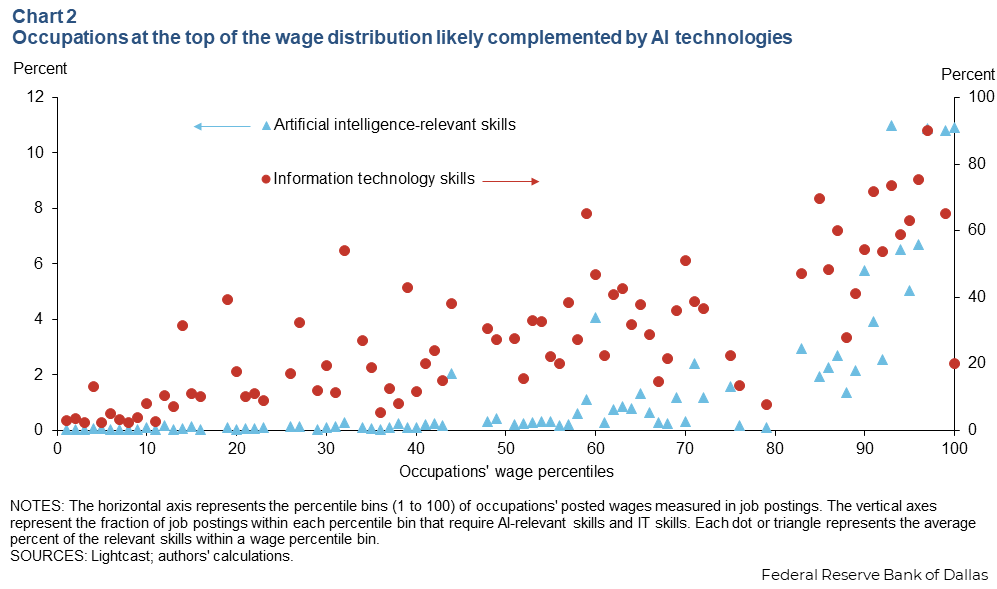
This suggests that workers at the very top of the wage distribution may be complemented by AI advancement, making them its beneficiaries, while the high-skilled workers outside of the very top may have their jobs rendered vulnerable to AI.
The insight is consistent with the prediction from existing research that the development of AI is likely to slightly reverse the wage inequality between workers below the 90th wage percentile, but that the gap between the workers at the very top and everyone else may continue to widen with the AI shock.
Uneven exposure to AI across geography
Because of the distinct compositions of industries across regions, they often fare very differently when technological shocks hit the labor market. The automation shock hit places such as the industrial Rust Belt particularly hard, while high-skilled coastal cities fared well as local productivity was boosted by the adoption of computer technologies. In contrast, the AI shock is expected to render the workforce in the large high-skilled cities vulnerable while leaving the smaller and lower-skilled cities relatively unaffected.
Chart 3 shows select cities’ exposure to the three technological shocks, shown as the mean exposure percentile of the job postings in the metro to each shock.
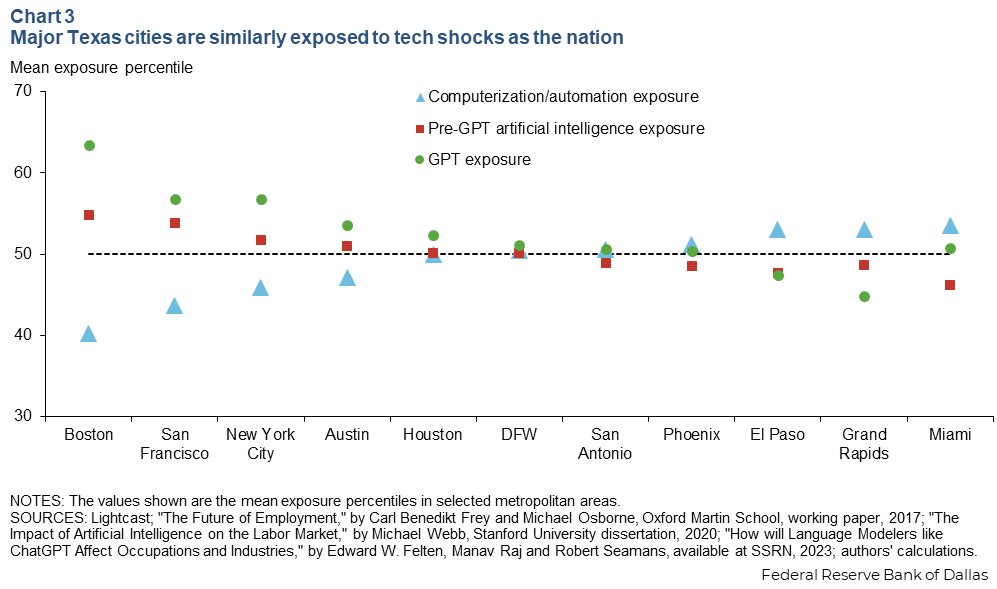
Higher percentiles mean more of the jobs posted in the metro are vulnerable or exposed to the new technology. Cities such as New York, Boston and San Francisco are the least exposed to automation but are much more exposed to AI shocks, especially to the shocks from generative AI, because of these cities’ large workforces in high-skilled and creative professions.
By comparison, in cities such as Grand Rapids, Michigan, which is a major manufacturing center in the Midwest, the exposure profile is entirely reversed: Exposure to automation tends to be much higher, while exposure to AI, in particular generative AI, is low.
As a state, Texas is ranked in the middle of the pack in terms of exposure to any of these technological shocks. This is largely because the composition of the Texas workforce mimics that of the nation.
But within Texas, Austin is less exposed to automation but more exposed to AI, while El Paso is the reverse. This is because Austin has a large presence of the AI-exposed occupations such as tech and professional services, while El Paso hosts more automation-exposed occupations such as food services and office and administrative support. Occupational exposure to either automation or AI in Dallas–Fort Worth, Houston and San Antonio tends to be close to the national median.
Across the nation, cities with high concentrations of college-educated workers tend to be more exposed to AI technologies, especially the generative AI shock (Chart 4). This distribution is the opposite of the automation shock, which disproportionately hit cities with significant shares of noncollege-educated workforces. AI shocks may potentially reverse some of the well-documented geographic disparity in wage and job opportunities as well.
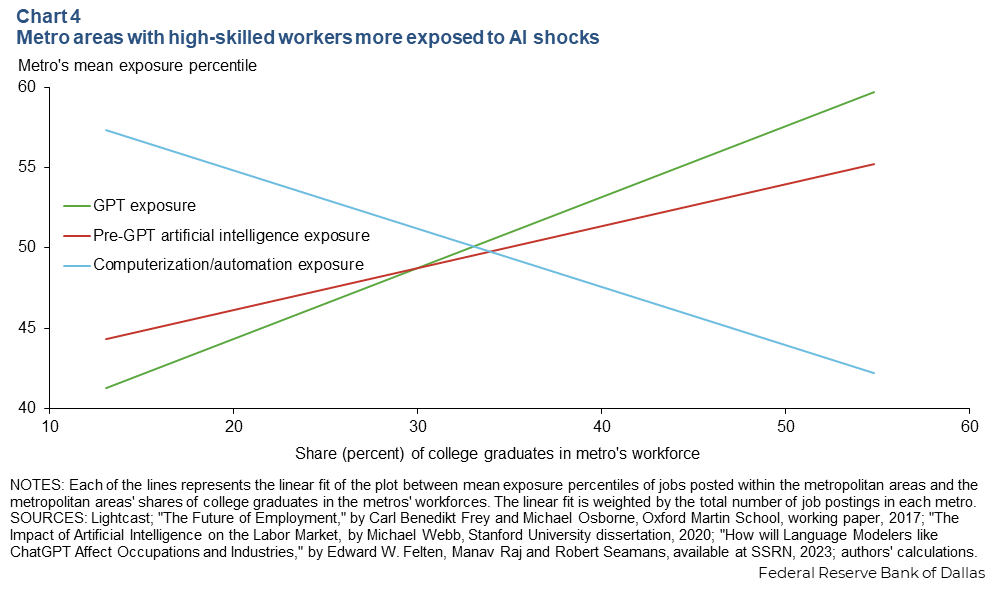
The caveat of this prediction is that while higher-skilled cities, on average, tend to be more exposed to AI shocks, the few elite cities with the highest concentration of highest-skilled workers are likely home to most of the workers whose productivity will be augmented by rather than displaced by AI advancement.
A 2021 Brookings report corroborated this distinction. It cited the potential for a “winner-takes-most” outcome as cities compete for AI dominance. If this prediction pans out, the disparity between the few highly skilled enclaves and the rest of the nation could widen further.
That said, AI has the potential to change the way we work, consume and live, both for the better and for the worse. AI could lower the costs of professional services (such as financial planning or legal representation), allowing ordinary consumers and small businesses to afford services previously out of reach.
On the research and development side, AI tools could open the door to new scientific innovations. Moreover, the computer shock and the technologies developed in the past few decades led to the creation of new types of jobs. It stands to reason that AI could lead to the formation of totally new lines of work.
Notes
- The occupations are then ranked by percentile based on the respective exposure measure.
- The occupational composition is given by the sample of all online job postings during 2018–23 (partial year of 2023 from January to May) collected by Lightcast.
- A job posting is defined as requiring AI-relevant skills if any of the following skills are listed: AI, artificial intelligence, algorithm, API, application programming interface, machine learning, neural networks, natural language processing, virtual reality (VR), augmented reality (AR), object recognition, image recognition, speech recognition, emotion recognition, deep learning, computer vision, unsupervised learning, search engine optimization (SEO), cloud computing, platform as a service (PaaS), cloud security application, cloud security architecture, cloud security data protection and privacy, cloud security infrastructure, cloud security planning, cloud security strategy, cloud security strategy and planning, cloud strategy, data science. A job posting is defined as requiring IT skills if any skills falling under the skill cluster family “information technology” are listed.



